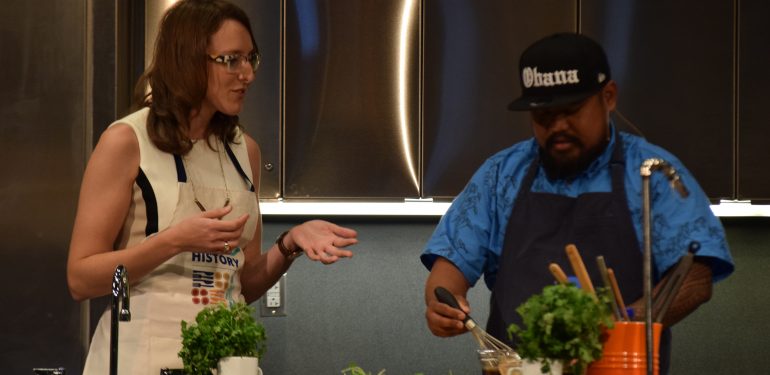THE SMITHSONIAN NATIONAL MUSEUM OF AMERICAN HISTORY HAD THEIR 3RD ANNUAL FOOD HISTORY WEEKEND ON OCT. 26-28TH
By Hailey Bullis, Staff Writer
From Chinese food, Japanese, Mexican, or Italian, there are many different types of food readily available in American culture. However, the history of those foods and cultures are often overlooked. To teach America about the foods they eat, the National Museum of American History hosted their third annual Smithsonian Food History this past weekend, Oct. 26-28. The event included various panels and events that showcased various dishes and chefs from around the globe.
On Oct. 27, the museum had various chefs speak while doing a live cooking demonstration for the audience. One such chef was Sheldon Simeon, who was a contestant on the show Top Chef in season ten and fourteen, where he was voted fan favorite during both runs.
Simeon is originally from Hawai’i and his presentation was titled the “Many Flavors of Hawai’i” in honor of that. When one thinks of Hawaiian cuisine, they might think of the the fruit drizzles or coconut drinks travel agencies made the identity of Hawaii, but through his presentation Simeon showed that Hawaiian cuisine is so much more and so much simpler than what advertisements show.
Hawaiian cuisine started with the polynesian voyagers, who in Simeon’s words, took with them “very simple ingredients: sea salt, kukui nuts, some bananas, and some coconut, and some bread fruit.” Beyond that, Hawai’i was visited by many other groups over the centuries from spanish cowboys to the Japanese who came to work on sugar plantations. Because of this, Hawaiian cuisine has influences from Spain, China, Portugal, Japan, Puerto Rico, Korea, and the Philippines.
For his live cooking demonstration Simeon made Chicken Hekka, a dish with roots in Japan, and influences from China and Okinawa. The dish includes long rice, vegetables, chicken and special sauce consisting of brown sugar, mirin, and soy sauce mixed together.
Simeon decided to make Chicken Hekka because he wanted a unique dish that was central to Hawaiian culture.
“I wanted to do a dish that you wouldn’t hear of anywhere else and it’s a blending of three different cultures, which is what goes on with a lot of dishes in Hawai’i,” said Siemon, “This is a dish I grew up eating, although my parents were filipino, we cooked a lot of [ethnic foods].”
Beyond Simeon’s demonstration, the weekend included deep dish dialogues, a gala, kid’s tables, book signings, and panels focusing on topics like immigration’s influence on American cuisine and how working in the food industry controlled the experiences of immigrants.
Photos Courtesy of Hailey Bullis




